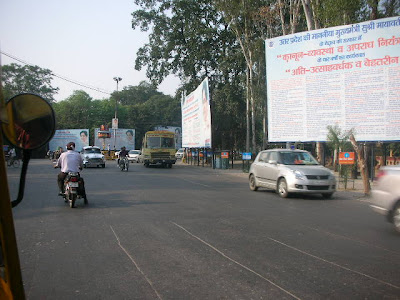I do not watch much television. I don’t read newspapers or magazines, either. Very little in them interests me or engages me any more. My viewing and reading is increasingly over the Internet where I can search for stuff that interests me.
Last week, however, I was in Lucknow on holiday, and without the laptop. I ended up whiling a few hours in the hotel room in front of the television. And I found myself having a perverse attraction to two shows on Channel [V] in particular – Love Net 2.0 and Axe Your Ex.
I say perverse because these shows (and others like Dare To Date on the same channel and Emotional Atyachar on Bindass) pander to two of our basest desires for their success – the first is the desire of having a fantasy coming true (meeting your chat friends, revenge on your ex, spying on your boyfriend, going on a blind date) and the second, the voyeuristic urge to know the personal details of other people’s lives.
While watching these shows, I couldn’t help reflecting on the journey of the music (now turned youth) channels over the past two decades. They were “cool” in the early 90′s when they launched, transformed themselves to “desi cool” at the turn of the decade, and now are just plain “desi”. In a way, the sensibility has travelled, very evidently, from South Bombay to West Delhi. From people in ivory towers in South Mumbai producing what they think we should be watching, we now have people in ivory towers in Gurgaon producing what they think we want to watch.
It’s not just our youth channels that have made this journey. It’s the trend across channels. Fantasies come true when an Akshay Kumar hosts Masterchef India. Voyeurism is the USP of Big Boss and our daily soaps. Our news channels are full of it. And then there’s the IPL.
There’s nothing wrong in this Delhi-isation. Of course, Delhi-isation is a harsh term to use. It reinforces the unfortunate stereotype of Bombay being sophisticated and Delhi being boorish (which they aren’t), and doesn’t do justice to the good work coming out of this phenomenon, especially in films and advertising. Filmmakers like Anurag Kashyap and Dibakar Banerji are putting their Delhi sensibility to good use in their work and presenting a view of contemporary Delhi in much the same way as Hrishikesh Mukherji and Basu Chatterjee used to do with Bombay in the 70′s. And Piyush Pandey rewrote the rules in advertising by bringing Delhi to his work.
The reason for the increased Delhi-isation of our media is also due to a shift in our influences from British to American. Compare NDTV which started off as a BBC clone and transformed itself to a clone of Fox News. Or our cricket coverage whose packaging resembles that of any sport on American TV.
It may well be that Delhi-isation is a phase we have to pass through, before we become Kolkata-ised, like we were before the 70′s.
I’m reminded of a similar analysis of this phenomenon by the Bates planning team that explains it as a transition from Brahminical values to Kshatriya. You can read that here.
Friday, October 28, 2011
Tuesday, October 25, 2011
Badi Behenji is watching you



Step out of Lucknow’s Amausi airport and you are greeted by giant hoardings proclaiming Mayawati’s achievements with Behenji smiling benignly from them. Leave the airport and drive into the city, and you’ll be haunted by them at every street corner there is.
We had come to Lucknow for a leisurely break. An unlikely destination for one, for sure, as people kept reminding me. “Lucknow?! On a holiday?” We were prepared to stay put in our hotel and just enjoy our time together. But Lucknow surprised us, and pleasantly.
I looked around for hints of the city’s famed tehzeeb. But other than being called ‘janaab’ instead of ‘sahab’ by autorickshaw drivers, shop salesmen and sundry others, I didn’t find much of it.
We avoided Mayawati’s grand parks with elephants that cost a crore each to sculpt and her handbags immortalised in stone (“I refuse to see such a colossal waste of public money,” as the wife put it), and instead opted to visit Lucknow’s heritage.
Amid the ruins of the Residency, where the mutineers of 1857 laid seige, we found ourselves invading the privacy of numerous amorous couples. We bid a hasty retreat to the Bada Imambara where guides are trained to parrot out the same old information while giving it a fresh new twist. So we encountered medieval age ‘CCTV cameras’ and other modern-day security features.
All this while, Lucknow’s autorickshaw drivers made sure they had a good Diwali at our expense. I’d always thought the biggest rogues in India were Chennai’s auto-walas, but Lucknow’s, I discovered, beat them by a fair distance. The Lucknow autorickshaw driver only counts in multiples of 50. He knows no other numbers.
At Hazratganj, Lucknow’s colonial shopping district, there seems to be a law that all signage on heritage buildings have to be white on a black background. It was quite interesting to see the all-too-familiar Airtel and Vodafone logos shorn of their brand colours. If you are a brand manager with one of them, don’t visit Hazratganj. You’ll have the worst nightmare of your life.
I couldn’t take a picture of it, but here’s a photo I found at http://sites.google.com/site/lovelylucknow/hazratganj_lucknow that will give you an idea of what to expect.

Subscribe to:
Comments (Atom)
